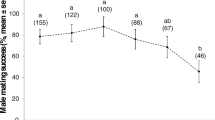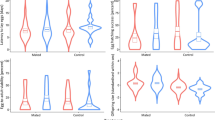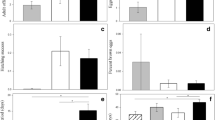Abstract
In lekking species, females may become sperm-limited when mating with sexually successful males, and this may be exacerbated by a poor male diet. Polygynous males may also be limited by the amount of accessory gland products (AGPs) they can transmit to females, which in turn may influence the females’ refractory period and longevity. Here, we tested the effect of male mating history, larval and adult diet on copula duration, mating intervals, female fecundity, fertilisation success, life span and likelihood to remate using sexually successful males of the lekking tephritid fly Anastrepha obliqua. Flies originated from either a native or exotic host fruit and were protein-fed or deprived. Male diet and larval host influenced copula duration, while the time elapsed between matings was affected by the interaction of mating order and male adult diet. Female fecundity was not influenced by female position in mating order or protein inclusion into the male diet. However, mating order and male larval diet influenced female fertilisation success. Importantly, as males mated successively they were less able to induce a refractory period on females, as the last females to mate with a male were more likely to remate and had slightly longer life spans than the first females to mate with males. These results might be attributed to a decrease in male AGPs with increasing male mating frequency. We discuss the role of conditional expression of male mating frequency with respect to A. obliqua’s life history, the trade-off that females face when mating with a successful male, the effect of larval diet on adult sexual performance and the possibility for sexual conflict to occur due to high male mating rates and fitness costs to females.




Similar content being viewed by others
References
Aluja M, Birke A (1993) Habitat use by adults of Anastrepha obliqua (Diptera: Tephritidae) in a mixed mango and tropical plum orchard. Ann Entomol Soc Am 86:799–812
Aluja M, Piñero J, Jácome I, Díaz-Fleischer F, Sivinski J (2000) Behavior of flies in the genus Anastrepha (Trypteinae: Toxotrypanini). In: Aluja M, Norrbom AL (eds) Fruit flies (Tephritidae): phylogeny and evolution of behavior. CRC, Boca Raton, FL, USA, pp 375–408
Aluja M, Jácome I, Macías-Ordóñez R (2001a) Effect of adult nutrition on male sexual performance in four tropical fruit fly species of the genus Anastrepha (Diptera: Tephritidae). J Insect Behav 14:759–775 DOI 10.1023/A:1013037400676
Aluja M, Díaz-Fleischer F, Papaj DR, Lagunes G, Sivinski J (2001b) Effects of age, diet, female density and host resource on egg-load in Anastrepha ludens and A. obliqua (Diptera: Tephiritidae). J Insect Physiol 47:975–988
Arnqvist G, Danielsson I (1999) Postmating sexual selection: the effects of male body size and recovery period on paternity and egg production rate in a water strider. Behav Ecol 10:358–365
Arnqvist G, Rowe L (2005) Sexual Conflict. Princeton University Press, Princeton
Blay S, Yuval B (1997) Nutritional correlates of reproductive success of male Mediterranean fruit flies (Diptera: Tephritidae). Anim Behav 54:59–66 DOI 10.1006/anbe.1996.0445
Chapman T, Liddle LF, Kaib JM, Wolfner MF, Partridge L (1995) Cost of mating in Drosophila melanogaster females is mediated by male accessory gland products. Nature 373:241–244 DOI 10.1038/373241a0
Chen PS (1984) The functional morphology and biochemistry of insect male accessory glands and their secretions. Annu Rev Entomol 29:233–255 DOI 10.1146/annurev.en.29.010184.001313
Cook RD, Weisberg S (1999) Applied Regression Including Computing and Graphics. Wiley-Interscience, New York
Cordero C (1995) Ejaculate substances that affect female insect reproductive physiology and behavior: honest or arbitrary traits? J Theor Biol 174:453–461 DOI 10.1006/jtbi.1995.0111
Damiens D, Bovin G (2005) Why do sperm-depleted parasitoid males continue to mate? Behav Ecol 17:138–143 DOI 10.1093/beheco/arj009
Dewsbury DA (1982) Ejaculate cost and male choice. Am Nat 119:601–610
Díaz-Fleischer F, Aluja M (2003a) Behavioural plasticity in relation to egg and time limitation: the case of two fly species in the genus Anastrepha (Diptera: Tephritidae). Oikos 100:125–133 DOI 10.1034/j.1600-0706.2003.12134.x
Díaz-Fleischer F, Aluja M (2003b) Clutch size in frugivorous insects as a function of host firmness: the case of the tephritid fly Anastrepha ludens. Ecol Entomol 28:268–277
Droney DC (1998) The influence of nutritional content of the adult male diet on testis mass, body condition and courtship vigour in a Hawaiian Drosophila. Funct Ecol 12:920–928 DOI 10.1046/j.1365-2435.1998.00266.x
Eben A, Benrey B, Sivisnki J, Aluja M (2000) Host species and host plant effects on preference and performance of Diachasmimorpha longicauta (Hymenoptera: Braconidae). Environmen Entomol 29:87–94 DOI 10.1603/0046-225X(2000)029[0087:HSAHPE]2.0.CO;2
Gage MJG, Cook PA (1994) Sperm size or numbers? Effects of nutritional stress upon eupyrene and apyrene sperm production strategies in the moth Plodia interpunctella (Lepidotera: Pyralidae). Funct Ecol 8:594–599
Gillot C (2003) Male accessory gland secretions: modulators of female reproductive physiology and behavior. Annu Rev Entomol 48:163–184 DOI 10.1146/annurev.ento.48.091801.112657
Höglund J, Alatalo RV (1995) Leks. Princeton University Press, Princeton
Jácome I, Aluja M, Liedo P, Nestel D (1995) The influence of adult diet and age on lipid reserves in the tropical fruit fly Anastrepha serpentina (Diptera: Tephritidae). J Insect Physiol 41:1079–1986 DOI 10.1016/0022-1910(95)00067-5
Jang EB (1995) Effects of mating and accessory gland injections on olfactory-mediated behavior in the female Mediterranean fruit fly, Ceratitis capitata. J Insect Physiol 41:705–710 DOI 10.1016/0022-1910(95)00015-M
Jiménez-Pérez A, Wang Q (2004) Male remating behavior and its effects on female reproductive fitness in Cnephasia jactatana Walker (Lepidoptera: Tortricidae). J Insect Behav 17:685–694 DOI 10.1023/B:JOIR.0000042549.59147.50
Jones TM (2001) A potential cost of monandry in the lekking sandfly Lutzomyia Longipalpis. J. Insect Behav 14:385–399 DOI 10.1023/A:1011127514317
Marcotte M, Delisle J, McNeil JN (2005) Impact of male mating history on the temporal sperm dynamics of Choristoneura rosaceana and C. fumiferana females. J Insect Physiol 51:537–544 DOI 10.1016/j.jinsphys.2004.12.009
Marcotte M, Delisle J, McNeil JN (2006) Impact of male mating history on the postmating resumption of sexual receptivity and lifetime reproductive success in Choristoneura rosaceana females. Phys Entomol 31:227–233 DOI 10.1111/j.1365-3032.2006.00510.x
Michereff MFF, Vilela EF, Filho MM, Nery DMS, Thièbaut JT (2004) Effects of delayed mating and male mating history on the reproductive potential of Leucoptera coffeella (Lepidoptera: Lyonetiidae). Agric Forest Entomol 6:241–247 DOI 10.1111/j.1461-9555.2004.00227.x
Montrose VT, Harris WE, Moore PJ (2004) Sexual conflict and cooperation under naturally occurring male enforced monogamy. J Evol Biol 17:443–452 DOI 10.1046/j.1420-9101.2003.00654.x
Mossinson S, Yuval B (2003) Regulation of sexual receptivity of female Mediterranean fruit flies: old hypotheses revisited and a new synthesis proposed. J Insect Physiol. 49:561–567 DOI 10.1016/S0022-1910(03)00027-1
Nakagawa S, Farias GJ, Suda D, Cunningham RT, Chambers DL (1971) Reproduction of the Mediterranean fruit fly: frequency of mating in the laboratory. Ann Entomol Soc Am 64:949–950
Norrbom AL (2004) Host plant database for Anastrepha and Toxotrypana (Diptera: Tephritidae: Toxotripanini) Diptera Data Dissemination Disk 2 (CD-ROM-Vol. 2). USDA-APHIS
Pérez-Staples D, Aluja M (2004) Anastrepha striata (Diptera: Tephritidae) females mated to virgin males live longer. Ann Entomol Soc Am 97:1336–1341 DOI 10.1603/0013-8746(2004)097[1336:ASDTFT]2.0.CO;2
Perez-Staples D, Aluja M (2006) Sperm allocation and cost of mating in a tropical tephritid fruit fly. J Insect Physiol 52:839–845 DOI 10.1016/j.jinsphys.2006.05.007
Perez-Staples D, Prabhu V, Taylor PW (2007) Post-teneral protein feeding enhances sexual performance of Queensland fruit flies. Phys Entomol 32:127–153 DOI 10.1111/j.1365-3032.2007.00568.x
Pinheiro JC, Bates MD (2000) Mixed Effects Models in S and S-plus. Springer, New York City
Radhakrishnan P, Taylor PW (2007) Seminal fluids mediate sexual inhibition and short copula duration in mated Queensland fruit flies. J Insect Physiol 53(7):741–745 DOI 10.1016/j.jinsphys.2006.10.009
Rogers DW, Chapman T, Fowler K, Poniankowski A (2005) Mating-induced reduction in accessory reproductive organ size in the stalk-eyed fly Cyrtodiopsis dalmanni. BMC Evol Biol 5:37 DOI 10.1186/1471-2148-5-37
Royer L, McNeill JN (1993) Male investment in the European corn borer, Ostrinia nubilalis (Lepidoptera: Pyralidae): impact on female longevity and reproductive performance. Funct Ecol 7:209–215
Savalli UM, Fox CW (1999) The effect of male mating history on paternal investment, fecundity and female remating in the seed beetle Callosobruchus maculatus. Funct Ecol 13:169–177 DOI 10.1046/j.1365-2435.1999.00287.x
Simmons LW (2001) Sperm competition and its evolutionary consequences in the insects. Princeton University Press, Princeton, NJ, USA
Smith PH, Gillott C, Browne LB, Van Gerwen ACM (1990) The mating-induced refractoriness of Lucilia curpina females: manipulating the male contribution. Physiol Entomol 15:469–481
Svärd L, Wiklund C (1986) Different ejaculate delivery strategies in first versus subsequent matings in the swallowtail butterfly. Behav Ecol Sociobiol 18:325–330 DOI 10.1007/BF00299663
Svensson MGE, Marling E, Löfqvist J (1998) Mating behavior and reproductive potential in the turnip moth Agrotis segetum (Lepidoptera: Noctuidae). J Insect Behav 11:343–359 DOI 10.1023/A:1020998513316
Taylor PW, Yuval B (1999) Postcopulatory sexual selection in Mediterranean fruit flies: advantages for large and protein-fed males. Anim Behav 58:247–254 DOI 10.1006/anbe.1999.1137
Trujillo G (1998) Efecto de la dieta, tamaño de los adultos, presencia de hospedero y condición fértil o estéril de los machos en el número de apareamientos y periodo refractorio de hembras de Anastrepha ludens (Loew) y Anastrepha obliqua (Macquart) (Diptera: Tephritidae). BSc thesis, Universidad Veracruzana, Xalapa, Veracruz, Mexico
Wagner WE, Kelley RJ, Tucker KR, Harper CJ (2001) Females receive a life-span benefit from male ejaculates in a field cricket. Evolution 55:994–1001
Wedell N, Gage MJG, Parker GA (2002) Sperm competition, male prudence and sperm-limited females. Trends Ecol Evol 17:313–320 DOI 10.1016/S0169-5347(02)02533-8
Whittier TS, Kaneshiro KY (1991) Male mating success and female fitness in the Mediterranean fruit fly (Diptera: Tephritidae). Ann Entomol Soc Am 84:608–611
Acknowledgments
We sincerely thank six anonymous referees and two associate editors for many insightful comments and suggestions for improvement. We are also very grateful to Carlos Cordero (Instituto de Ecología, UNAM) for helpful suggestions and discussion throughout the project as well as for comments on the manuscript. Melissa Galicia and Lizbeth González provided critical technical assistance throughout the study. We thank Francisco Díaz-Fleischer, the technicians in Desarrollo de Métodos in the Moscafrut program, Tapachula, Chiapas, Mexico, and Martin Pale (Instituto de Ecología, A.C.) for helping us obtain pupae. We also thank Roberto Munguía-Steyer for statistical advice and Larissa Guillén and Nicoletta Righini (Instituto de Ecología, A.C.) for their general assistance. Financial support was provided by the Mexican Campaña Nacional Contra las Moscas de la Fruta (Secretaría de Agricultura, Ganadería, Desarrollo Rural y Pesca-Instituto Interamericano de Cooperación para la Agricultura) and a competitive grant from the Mexican Consejo Nacional de Ciencia y Tecnología (Project CONACYT-SEP-2004-C01-46846). This is part of the PhD dissertation of DPS, directed by MA and supported by CONACyT through a fellowship to DPS. The experiments performed here comply with the current laws of Mexico.
Author information
Authors and Affiliations
Corresponding author
Additional information
Communicated by G. Wilkinson
Rights and permissions
About this article
Cite this article
Perez-Staples, D., Aluja, M., Macías-Ordóñez, R. et al. Reproductive trade-offs from mating with a successful male: the case of the tephritid fly Anastrepha obliqua . Behav Ecol Sociobiol 62, 1333–1340 (2008). https://doi.org/10.1007/s00265-008-0561-0
Received:
Revised:
Accepted:
Published:
Issue Date:
DOI: https://doi.org/10.1007/s00265-008-0561-0




